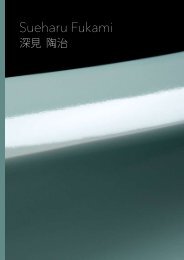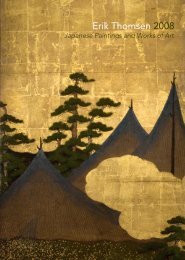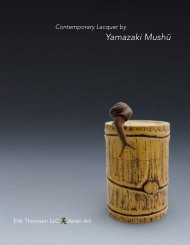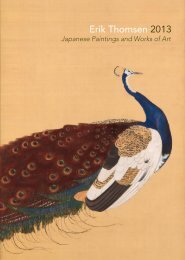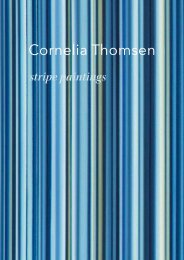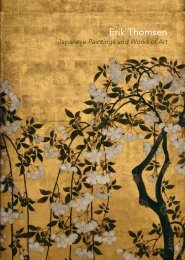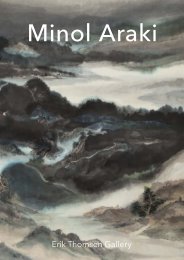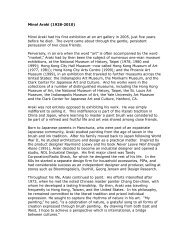View publication (pdf file 6.5 mb) - Erik Thomsen
View publication (pdf file 6.5 mb) - Erik Thomsen
View publication (pdf file 6.5 mb) - Erik Thomsen
- No tags were found...
Create successful ePaper yourself
Turn your PDF publications into a flip-book with our unique Google optimized e-Paper software.
6Hirai Baisen 平 井 楳 仙 (1889 –1969)Chinese Landscape with PagodaTaishō Period (1912 – 26), 1925H 68" × W 74 ¾"(173 cm × 189.7 cm)Two-panel folding screenInk and colors on paperSignature: Baisen 楳 仙Seal: »Painted by Hirai Baisen« 比 羅 居 白 仙 画A series of perpendicular cliffs, precipitous gorgesand towering temple pagodas gives this remarkablelandscape painting a sense of peril and exoticism.The setting is not Japan: this painting stemsfrom Hirai Baisen’s Chinese phase, a period that heentered after his travel to China in 1913. Here is apainting with rough strokes of ink on paper in theold tradition of depicting Chinese scenes, a traditionthat goes back to Sesshū (1420 –1506).We see the artist’s great skill in his use of ink. Notonly does he use ink in many modalities, varyingfrom intense black to faint grey, but he also variesthe wetness of the brush, creating a misty feel tothe vegetation, as some sections are vague whileothers are in sharp focus, lending to an atmosphereof misty mountain peaks. We also see a greatvariety in brush patterns, with some brushes roughand hard-bristled; Baisen uses these repeatedlyto get a sense of wild vegetation on the cliff sides.Another indication of his love for experimentationcan be found in the special paper he used for thiswork: both sides of the screen are painted on asingle large, custom-made sheet of paper, whichis unusual for this scale of work.Baisen has used colors sparingly with carefuldeliberation. To the landscape he added a wellbalanced,faint application of red-brown colors.These colors impart an autumnal feel to the sceneand at the same time create a color palette thatis exotic—it is after all not a scene from Japan, butone from a foreign, yet familiar, culture that Baisenportrays. The light blue color used in one spot, onthe coat edge of the single Chinese traveler, addsan exotic touch.A nu<strong>mb</strong>er of other examples exist from the artist’speriod of intense immersion into Chinese expressiveness.For example, a pair of six-panel screensin the Honolulu Academy of Arts displays the samekind of composition and textual strokes. 1 Here, too,we see a towering pagoda in the distance over ravinesand a precipitous landscape. What differentiatesthe two works from each other is that the Honoluluscreens are solely expressed in ink, whereasin the present work we see his experiment with colorsand a more complex composition.The screen was created in 1925 when Baisen waspreparing a series of screens with ink paintingsof Chinese landscapes for the sixth Teiten exhibitionof 1925. Two other sets of the screens createdduring this burst of energy have recently beenpublished. 2Baisen is a painter of many styles who succeeds insurprising at every turn. 3 A look at another paintingby him in this <strong>publication</strong> item15, (a snow sceneof the Kamogawa River dated to 1917) shows howgreatly his style changed over a few years. Constantis his technical excellence and his fascination withvarious materials and tools: the brushes, the paints,and the surfaces. We see him forever experimentingwith new ideas. He was clearly an intellectualpainter at the cutting edge of the twentieth-centuryNihonga movements during his early years. 4 Thescreens are a testament to the genius of Baisen ashe revisits the iconic masterpieces of the past andsuccessfully reworks them into a new vocabulary ofhis own.32 33



